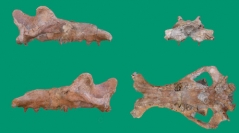

 Comptes Rendus Palevol
21 (7) - Pages 157-173
Comptes Rendus Palevol
21 (7) - Pages 157-173An almost complete cranium of a juvenile individual from the late Early Pleistocene site of Buia, in the northern Afar (Danakil) Basin in Eritrea, reveals a different growth pattern of the extinct species Hippopotamus gorgops Dietrich, 1928 compared to the extant species Hippopotamus amphibius Linnaeus, 1758. The specimen shows important cranial features of Hip. gorgops (also visible in adult specimens), with a derived cranial anatomy that is related to the specialization to a more aquatic life style than other species of Hippopotamidae: elevated nuchal and sagittal crests, strongly elevated orbital cavities, short neurocranium and elongated palate. A geometric morphometrics analysis was performed in the lateral view on skulls of Hip. gorgops and Hip. amphibius, to investigate size-shape relationship and to compare ontogenetic growth trajectories between both taxa. The study revealed that, during growth (increase in size and age), variations in skull shape are prominent in Hip. amphibius; juvenile and adult individuals of Hip. gorgops display strong morphological similarities but size and shape are poorly correlated. The results support the hypothesis that in a relatively early ontogenetic stage, Hip. gorgops was more specialized in its aquatic adaptation than Hip. amphibius.
Juvenile, ontogeny, geometric morphometrics, Danakil depression, Buia, Eritrea